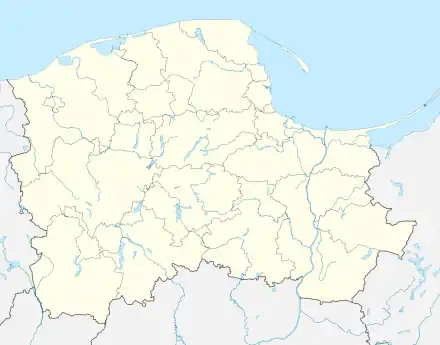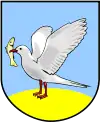Piaseczno, Tczew County
Piaseczno [pjaˈsɛt͡ʂnɔ] (German: Pehsken) is a village in the administrative district of Gmina Gniew, within Tczew County, Pomeranian Voivodeship, in northern Poland.[1] It lies approximately 6 kilometres (4 mi) south-west of Gniew, 34 km (21 mi) south of Tczew, and 64 km (40 mi) south of the regional capital Gdańsk. It is located within the ethnocultural region of Kociewie in the historic region of Pomerania.
Piaseczno | |
|---|---|
Village | |
 Panorama of Piaseczno with the Church of the Nativity of the Virgin Mary | |
 Piaseczno  Piaseczno | |
| Coordinates: 53°48′7″N 18°46′32″E | |
| Country | |
| Voivodeship | Pomeranian |
| County | Tczew |
| Gmina | Gniew |
| Population | 580 |
| Time zone | UTC+1 (CET) |
| • Summer (DST) | UTC+2 (CEST) |
| Area code(s) | +48 58 |
| Vehicle registration | GTC |
The village has a population of 580.
Piaseczno is a regional Christian pilgrimage destination due to the historic Piaseczno Well. Other sights of the village are the Gothic Church of the Nativity of the Virgin Mary and the Museum of the Polish Peasant Movement.
The settlement Piaseckie Pola is part of the village.[2]
History
_(12).JPG.webp)
Piaseczno was a royal village of the Polish Crown, administratively located in the Tczew County in the Pomeranian Voivodeship.[3] It was a popular Catholic pilgrimage destination and was often visited by starost of nearby Gniew and future King of Poland John III Sobieski.[4] As king he ordered the construction of a new, greater vault in the local church of the Nativity of the Virgin Mary, and visited Piaseczno shortly before his death in 1696.[4] His wife, Queen consort of Poland, Marie Casimire visited Piaseczno in 1676.[5]
In 1862, activist Juliusz Kraziewicz founded the oldest Polish agricultural cooperative (Włościańskie Towarzystwo Rolnicze) in the village.[4][6] Due to this, the Museum of the Polish Peasant Movement is located in the village.
During the German occupation of Poland (World War II), the local Polish parish priest Augustyn Bukolt was murdered by the Germans in a mass execution in the Szpęgawski Forest in October 1939 (see Intelligenzaktion).[7]
References
- "Central Statistical Office (GUS) - TERYT (National Register of Territorial Land Apportionment Journal)" (in Polish). 2008-06-01.
- Rozporządzenie Ministra Administracji i Cyfryzacji z dnia 13 grudnia 2012 r. w sprawie wykazu urzędowych nazw miejscowości i ich części, Dz. U. z 2013 r. poz. 200
- Marian Biskup, Andrzej Tomczak, Mapy województwa pomorskiego w drugiej połowie XVI w., Toruń, 1955, p. 112 (in Polish)
- Słownik geograficzny Królestwa Polskiego i innych krajów słowiańskich, Tom VIII, Warszawa, 1887, p. 47 (in Polish)
- Słownik geograficzny Królestwa Polskiego i innych krajów słowiańskich, Tom VIII, p. 47-48
- "Wystawa „150 lat Kółek Rolniczych w służbie polskiej wsi"". Tczewska.pl (in Polish). Retrieved 9 August 2020.
- "Augustyn Bukolt" (in Polish). Retrieved 9 August 2020.
